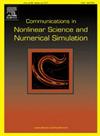局部反馈控制下螺旋波嵌合体的动力学
IF 3.8
2区 数学
Q1 MATHEMATICS, APPLIED
Communications in Nonlinear Science and Numerical Simulation
Pub Date : 2025-04-23
DOI:10.1016/j.cnsns.2025.108859
引用次数: 0
摘要
研究了二维三分量反应扩散系统中螺旋波嵌合体对测量位置反馈信号的响应。当反馈增益较小时,反馈迫使非相干磁芯沿具有指状凸起的圆形轨道运动,并且随着时延的增加,圆形路径结构更加复杂。当反馈增益较大时,波前的激励会使螺旋臂消失,只留下一些残余段,这些残余段将发展成具有多个非相干磁心的波结构,其中一个磁心位于测点。对于中间反馈增益,根据时间延迟确定了四种类型的动态行为,这些行为在正常螺旋波的局部反馈控制中无法观察到。对于前三种类型,螺旋嵌合体最终会消失,但会经历三个不同的过程,包括瞬态非相干弧的形成,非相干核心沿螺旋向边界漂移,以及瞬态闭合路径的复杂漂移。第四种类型出现在大的时间延迟中,其中非相干磁芯沿螺旋漂移到测点。这些结果与螺旋嵌合体的控制有关,其中螺旋嵌合体可以通过表现前三种动力学行为的反馈来消除,而螺旋嵌合体的核心可以通过表现第四种动力学行为的反馈来控制到指定的位置。本文章由计算机程序翻译,如有差异,请以英文原文为准。
Dynamics of spiral wave chimeras subjected to a local feedback control
The response of the spiral wave chimera on the feedback signal from a measuring location is investigated in the three-component reaction–diffusion system with two spatial dimensions. When the feedback gain is small, the feedback forces the incoherent core to follow a circular orbit with finger-shaped bulges, and the circular path exhibits more complex structures with an increases of the time delay. For a large feedback gain, the excitation in front of the wave front causes the disappearance of the spiral arm except for some residual segments, which will be developed into the wave structures with multiple incoherent cores, where one of the cores is located at the measuring point. Four types of dynamical behaviors are identified for an intermediate feedback gain, depending on the time delay, and these behaviors cannot be observed in the local feedback control of normal spiral waves. For the first three types, the spiral chimera will eventually disappear, but through three different processes, including the formation of transient incoherent arcs, the drift of the incoherent core to the boundary along a spiral, and the complex drift with a transient closed path. The fourth type appears for a large time delay, where the incoherent core drifts to the measuring point along a spiral. These results relate to the control of the spiral chimera, where the spiral chimera can be eliminated by the feedback exhibiting the first three dynamical behaviors, and its core can be controlled to the designated location by the feedback exhibiting the fourth dynamical behavior.
求助全文
通过发布文献求助,成功后即可免费获取论文全文。
去求助
来源期刊

Communications in Nonlinear Science and Numerical Simulation
MATHEMATICS, APPLIED-MATHEMATICS, INTERDISCIPLINARY APPLICATIONS
CiteScore
6.80
自引率
7.70%
发文量
378
审稿时长
78 days
期刊介绍:
The journal publishes original research findings on experimental observation, mathematical modeling, theoretical analysis and numerical simulation, for more accurate description, better prediction or novel application, of nonlinear phenomena in science and engineering. It offers a venue for researchers to make rapid exchange of ideas and techniques in nonlinear science and complexity.
The submission of manuscripts with cross-disciplinary approaches in nonlinear science and complexity is particularly encouraged.
Topics of interest:
Nonlinear differential or delay equations, Lie group analysis and asymptotic methods, Discontinuous systems, Fractals, Fractional calculus and dynamics, Nonlinear effects in quantum mechanics, Nonlinear stochastic processes, Experimental nonlinear science, Time-series and signal analysis, Computational methods and simulations in nonlinear science and engineering, Control of dynamical systems, Synchronization, Lyapunov analysis, High-dimensional chaos and turbulence, Chaos in Hamiltonian systems, Integrable systems and solitons, Collective behavior in many-body systems, Biological physics and networks, Nonlinear mechanical systems, Complex systems and complexity.
No length limitation for contributions is set, but only concisely written manuscripts are published. Brief papers are published on the basis of Rapid Communications. Discussions of previously published papers are welcome.
 求助内容:
求助内容: 应助结果提醒方式:
应助结果提醒方式:


